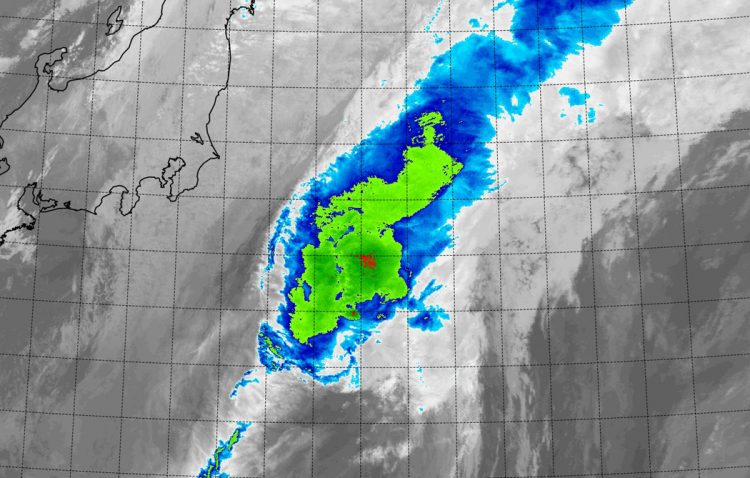NASA Sees Tropical Storm Nuri Resemble a Frontal System

NASA's Terra satellite passed over Tropical Storm Nuri on Nov. at captured an infrared picture of the storm. Nuri looked more like a frontal system stretching from northeast to southwest. Image Credit: NASA/NRL
The Moderate Resolution Imaging Spectroradiometer or MODIS instrument that flies aboard NASA's Terra satellite flew over Nuri on Nov. 6 at 1240 UTC (7:40 a.m. EST).
The MODIS image showed some strong thunderstorms remaining in a small area around Nuri's center, but the storm appeared stretched out from northeast to southwest. Wind shear was affecting the storm, stretching it out.
The last bulletin on the storm was issued on Nov. 6 at 0300 UTC (Nov. 5 at 10 p.m. EST). At that time, the Joint Typhoon Warning Center (JTWC) noted that Nuri still had maximum sustained winds near 55 knots (63.2 mph/102 kph).
It was located about 130 nautical miles (149 miles/240 km) west-northwest of Chichi-jima, near 29.2 north latitude and 141.0 east longitude. Nuri was moving to the northeast and over open waters of the western North Pacific.
In its final bulletin, JWTC noted that Nuri will become an extra-tropical storm before the end of the day on Nov. 6. Computer models indicate the system will be a strong extra-tropical low pressure area as it continues to move over open waters.
Rob Gutro
NASA's Goddard Space Flight Center
Media Contact
All latest news from the category: Earth Sciences
Earth Sciences (also referred to as Geosciences), which deals with basic issues surrounding our planet, plays a vital role in the area of energy and raw materials supply.
Earth Sciences comprises subjects such as geology, geography, geological informatics, paleontology, mineralogy, petrography, crystallography, geophysics, geodesy, glaciology, cartography, photogrammetry, meteorology and seismology, early-warning systems, earthquake research and polar research.
Newest articles

Sea slugs inspire highly stretchable biomedical sensor
USC Viterbi School of Engineering researcher Hangbo Zhao presents findings on highly stretchable and customizable microneedles for application in fields including neuroscience, tissue engineering, and wearable bioelectronics. The revolution in…

Twisting and binding matter waves with photons in a cavity
Precisely measuring the energy states of individual atoms has been a historical challenge for physicists due to atomic recoil. When an atom interacts with a photon, the atom “recoils” in…

Nanotubes, nanoparticles, and antibodies detect tiny amounts of fentanyl
New sensor is six orders of magnitude more sensitive than the next best thing. A research team at Pitt led by Alexander Star, a chemistry professor in the Kenneth P. Dietrich…





















